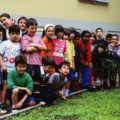An agreement was made in 1884 between the Italian Republic and the Vatican, modified by the Lateran Concorde of 1929, and ratified in a new law in 1985, which reads:
The Italian Republic, recognizing the value of religious culture, and keeping in mind that the principles of Catholicism are part of the historic patrimony of the Italian people, will continue to assure, among the broader goals of education, the teaching of the Catholic religion in all public schools below university level.
Respecting the freedom of conscience and educational responsibility of parents, everyone is guaranteed the right to choose whether or not to take advantage of such teaching.
When enrolling, students or their parents can exercise this right, upon request of the school authorities, and their choice may not give rise to any form of discrimination.
In accordance with the law, our daughter Rossella could have started religious education as early as pre-school. I was nervous about this, not wanting her to be catechized at such a young age, but also not wanting her to be the odd kid out. During the enrollment period, parents were invited to group meetings with the principal so that he could explain the school’s philosophy. To my surprise, one father’s biggest concern was to keep his child out of religious instruction – this man looked and sounded 100% Italian, but clearly was not very Catholic. The principal explained that, because he did not want any of his staff to teach religion, he had exercised his option to have a teacher provided by the local diocese. And, in accordance with the law, it was any parent’s right to opt out of this; a supervised alternate activity would be provided. That father and I were both much relieved.
A family friend faced a dilemma with her small child: she needed daycare, but the only place available near home was a private institution run by nuns. With some misgivings, she enrolled her son, and things went on well enough for several months. Until one day the boy came home and said to his mother: “Blessed art thou among women!” She withdrew him immediately.
Rossella’s lack of religious instruction was displayed to the public one day at a museum in Milan. After seeing many paintings of the crucifixion, she said loudly (in Italian): “What does this guy think he’s doing? A balancing act?” All heads snapped around to get a look at the pagan three-year-old.
In elementary school, Ross again did the alternativa, reading myths and legends from around the world and drawing illustrations for them. They also studied a simplified version of the UN’s Convention on the Rights of the Child. There were three or four other kids in alternativa with Ross (at least one of whom was Muslim), but most of the class were doing catechism in preparation for their confirmation (cresima – chrism) at age 9 or so. In some parts of Italian society, confirmation is a very big deal, with a fancy dress for the girls, a restaurant lunch hosted by the family, and presents – a sort of mini-wedding.
Although many prefer less fanfare and expense, most families do choose for their children to go through la cresima; it’s a tradition, though it seems to have lost most of its meaning. One little girl told me firmly: “I’m only going through this so that I can have a church wedding later on. After that, they’ll never see me again.”
The school Ross attended for 6th and 7th grade was very religious. Ross agreed that she should take religion class, to learn about this part of her Italian cultural heritage. The textbook was definitely Catholic, but no mere catechism, and the teaching was not heavy-handed. When she changed schools in 8th grade, she again took religion, and did well in the class, which even discussed some other religions.
In smaller towns, many kids who are not particularly religious or Catholic opt to participate in religion classes, simply because everyone else does – no kid wants to be the weirdo. One American friend’s son even asked if he could do the cresima, so as not to be the only kid in the class who didn’t (he hadn’t been baptized Catholic, so I’m not sure if that was possible).
In Lecco, Ross decided to take religion, like everyone else. It’s taught by a priest, Don Maurizio, but I like his attitude. The first day of class he told them: “I’m not here to convert anybody.” His main aim is to provoke the kids to think and talk about moral and ethical issues. Ross is thoughtful and articulate in his class, so he likes her, and is her champion with the other teachers (who seem to be having trouble understanding her).





